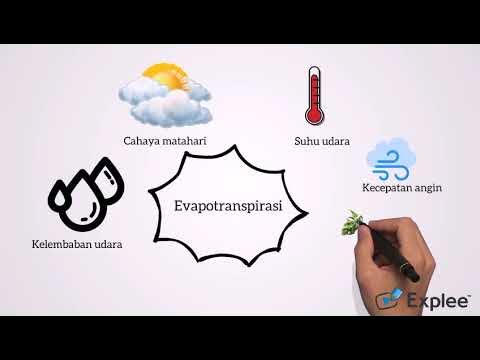Mengukur dan menghitung Evapotranspirasi
Summary
TLDRThis video discusses methods for estimating evapotranspiration (ET) in vegetated areas, with a focus on empirical formulas and techniques developed by Penman. The speaker explains the application of aerodynamic and energy balance principles, highlighting the importance of radiation, wind speed, and vapor pressure in ET calculations. The Bowen ratio is also explored as a means to measure ET through energy balance. The discussion emphasizes the complexity and data requirements needed for accurate ET estimation, offering insights into measuring both evaporation and transpiration in different ecosystems.
Takeaways
- 😀 Evapotranspiration (ET) is a critical process that involves both evaporation and transpiration from vegetation and soil, affecting the water cycle.
- 🌱 The Penman method is an empirical approach used to calculate ET by considering factors like wind speed, humidity, radiation, and vegetation.
- 💨 Aerodynamic influences play a significant role in estimating ET by considering wind speed and vapor pressure differences at varying heights.
- ☀️ Solar radiation is a key driver of ET, and its changes affect the energy balance in the atmosphere, influencing evaporation rates.
- 🌡️ Humidity differences between the soil surface and the atmosphere impact the amount of moisture that can evaporate, contributing to ET calculations.
- 📊 The Bowen ratio is used to estimate ET based on the balance between sensible and latent heat, with a ratio calculated from field data.
- 📏 Instruments like towers are used to measure temperature differences and vapor pressure at different heights to assess the Bowen ratio.
- 🌍 The empirical formula developed by Penman is adapted and further developed to account for local variables such as vegetation and land characteristics.
- 💧 Evaporation and transpiration are calculated by combining energy balance principles and various data sources, including wind speed and radiation.
- 🔬 Accurate measurement of ET relies on complex data from multiple environmental factors and sophisticated methods, such as the Bowen ratio, to assess the energy and moisture fluxes.
Q & A
What is the main focus of the video transcript?
-The video focuses on explaining the concept of evapotranspiration (ET), including the different methodologies used to estimate it and how factors like wind speed, radiation, and vegetation influence its calculation.
How does Penman's method of calculating evapotranspiration work?
-Penman's method calculates potential evapotranspiration using an energy balance approach that incorporates aerodynamic factors, radiation, vapor pressure, and environmental conditions such as humidity and wind speed.
What are the key factors that influence evapotranspiration as mentioned in the video?
-Key factors influencing evapotranspiration include wind speed, radiation, vapor pressure, vegetation, humidity, and temperature differences between surfaces.
What role does vegetation play in evapotranspiration according to the transcript?
-Vegetation plays a significant role in evapotranspiration as it influences the energy and moisture balance. It affects how water is transferred from the land surface to the atmosphere through both evaporation and transpiration.
What is the Bowen ratio and how is it used in estimating evapotranspiration?
-The Bowen ratio is the ratio of sensible heat flux to latent heat flux, and it is used in evapotranspiration estimation by measuring temperature and vapor pressure differences between two heights. It helps determine the energy balance and quantify evapotranspiration.
What is the difference between evaporation and transpiration as discussed in the video?
-Evaporation is the process of water turning into vapor from the soil or surface, while transpiration is the release of water vapor from plants. Both contribute to overall evapotranspiration.
How do complex data sets influence the accuracy of evapotranspiration estimates?
-Complex data sets, such as wind speed, temperature, humidity, and radiation, provide detailed environmental conditions that help improve the accuracy of evapotranspiration estimates. More data allows for a more comprehensive energy and moisture balance calculation.
What is the Penman-Monteith method and how does it differ from Penman’s method?
-The Penman-Monteith method is an extension of Penman’s original approach. It adds more complexity by incorporating additional aerodynamic factors and more precise energy balance calculations, including the influence of vegetation and surface moisture.
Why is it important to measure variables like vapor pressure and wind speed in evapotranspiration studies?
-Measuring variables like vapor pressure and wind speed is crucial because they directly affect the energy and moisture exchange between the surface and the atmosphere, which is essential for accurate evapotranspiration estimates.
What instruments are used to measure the data necessary for evapotranspiration calculations?
-Instruments like specialized towers are used to measure variables such as wind speed, temperature, radiation, and vapor pressure. These measurements provide the data required for calculating evapotranspiration using methods like Penman-Monteith and the Bowen ratio.
Outlines

This section is available to paid users only. Please upgrade to access this part.
Upgrade NowMindmap

This section is available to paid users only. Please upgrade to access this part.
Upgrade NowKeywords

This section is available to paid users only. Please upgrade to access this part.
Upgrade NowHighlights

This section is available to paid users only. Please upgrade to access this part.
Upgrade NowTranscripts

This section is available to paid users only. Please upgrade to access this part.
Upgrade NowBrowse More Related Video

Hidrologi - Evaporasi dan Evapotranspirasi

Evapotranspirasi

Hidrologia 1 Evapotranspiração 6 Medição de evapotranspiração

13. KHT - Hidrologi Hutan - Estimasi Debit Banjir (Bagian 2)

RUMUS KIMIA : RUMUS EMPIRIS DAN RUMUS MOLEKUL

Video Perhitungan Estimasi Bobot Badan Sapi, Kambing dan Domba Praktikum ITP 2023
5.0 / 5 (0 votes)